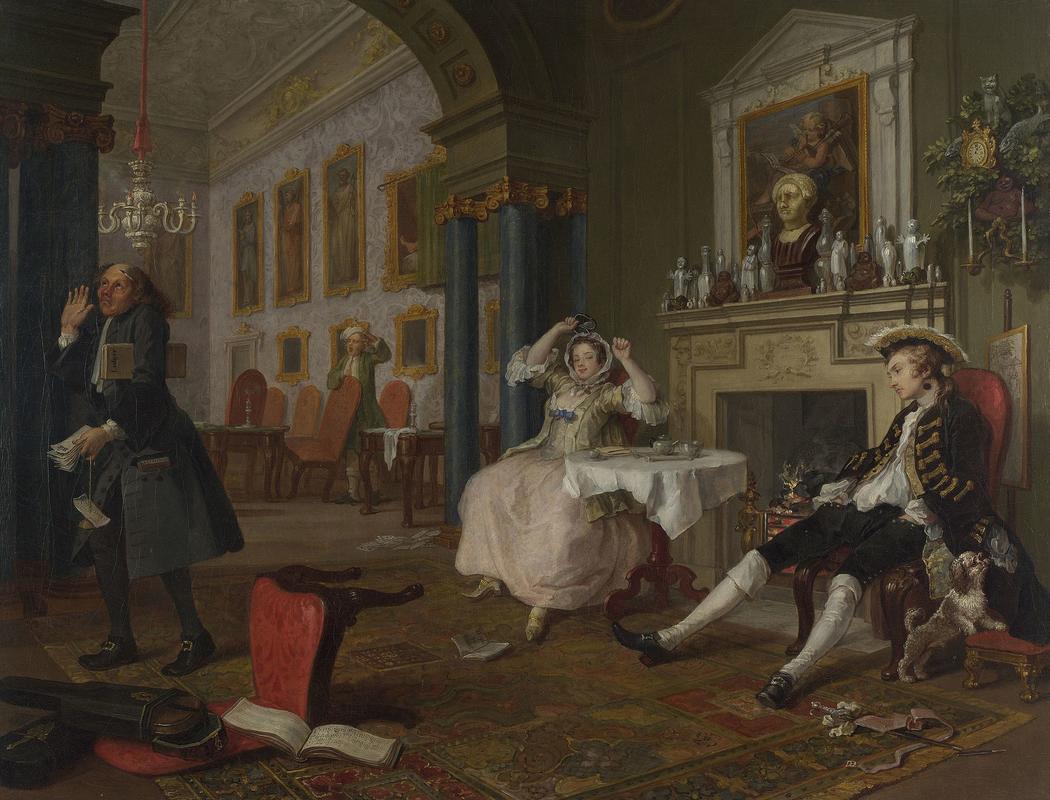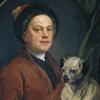More about Marriage A-la-Mode: 2, The Tête à Tête

Sr. Contributor
William Hogarth produced the first look into the lives of the rich and famous for the masses, Marriage À-la-Mode, and the second installment, the Tête à Tête, is the midseason finale.
William Hogarth is known for his satirical caricatures of the nouveau riche, but before his career mocking them, they were his patrons. He started off as a Rococo painter, creating small portraits for a wealthy clientele. He soon grew tired of this work as his true desire was to be a history painter and he was paid peanuts by his bourgeois patrons. He began recording humorous scenes from their everyday lives, poking fun at the aristocracy and using those incidents to tell a moralistic tale. These were popular with the public and allowed him to establish his financial and artistic autonomy.
One of Hogarth’s most famous works, Marriage À-la-Mode (“marriage in the style” in French) is the story of a marriage between the daughter of the bourgeois city merchant Alderman and the son of the noble but broke Earl Squanderfield. Like his first series A Harlot’s Progress and its sequel A Rake’s Progress, both also containing a moralizing message for the masses, it was first painted with the intention of converting it into a print. The first installment, The Marriage Settlement, shows the signing of the marriage contract. It is followed by the Tête à Tête, also called Shortly After the Marriage.
It has been one sinful night for the newlyweds. The clock shows that it is midday, his loose shirt indicating that the viscount has just gotten back from his walk of shame. His neck is exposed to reveal a patch indicating that he has a venereal disease, likely syphilis, and a broken sword is positioned on the floor next to him, alluding to impotence. The dog sniffs a girl’s cap hidden in his pocket, suggesting infidelity. The viscountess has had an equally scandalous night. She has been up all night playing cards, stretching with a sly look on her face. Her unnatural position may be due to the fact that she is signaling to her lover in her pocket mirror, the upturned chair a signal of his abrupt exit. The Methodist steward in the front has just about had it with the adulterous couple, holding a ledger of unpaid bills and ironically a book titled Regeneration in his pocket.
Hogarth not only uses the figures to portray immorality, but the interior design as well. The decor is a pastiche of chinoiserie and Rococo. The clock is overly elaborate, featuring a cat preying on fish on top of a buddha engulfed in a bush with two candlesticks. On the mantle lies two more buddha statues and Roman bust with a broken nose (another signifier of impotence), in front of a painting of Cupid playing the bagpipes and no string on his bow, alluding to marital discord. These classical pieces are surrounded by phallic statuettes.
The rest of the architecture is Neo-Palladian, another way for Hogarth to mock the couple. Neo-Palladian is an Italian style while Rococo is French, and the blending of the two would be seen as gauche. The paintings of the apostles Matthew, John, and Andrew in the back juxtapose the slightly hidden painting (probably a reclining nude) in the front with just an ankle shown, indicating lust.
In short, the scene shows the dysfunctional marriage between two frivolous aristocrats. Stay tuned for The Inspection, when the viscount and his mistress get tested for STDs.
Sources
- Benenson, Susan Elizabeth. “William Hogarth.” Encyclopaedia Britannia. Last modified February 6, 2019. https://www.britannica.com/biography/William-Hogarth
- De Voogd, Peter. “Generation in William Hogarth’s Marriage-a-la-mode,” in Les ges de la Vie en Grande-Bretagne Au XVIIIE Siècle. Paris : Presses Sorbonne Nouvelle, 1995.
- Egerton, Judy. "Hogarth's 'Marriage A-la-Mode' and the Copyist Adam Callander." The Burlington Magazine 145, no. 1199 (2003): 88-91.
- Erwin, Timothy. "William Hogarth and the Aesthetics of Nationalism." Huntington Library Quarterly 64, no. 3/4 (2001): 383-410.
- Gilbert, M. E. "Painter and Poet: Hogarth's "Marriage à La Mode" and Hofmannsthal's "Der Rosenkavalier"." The Modern Language Review 64, no. 4 (1969): 818-27.
Featured Content
Here is what Wikipedia says about Marriage A-la-Mode: 2. The Tête à Tête
The Tête à Tête is the second canvas in the series of six satirical paintings known as Marriage A-la-Mode, painted by William Hogarth.
Check out the full Wikipedia article about Marriage A-la-Mode: 2. The Tête à Tête












